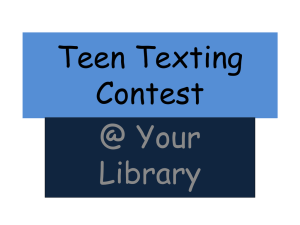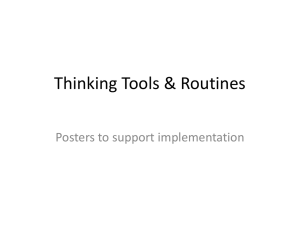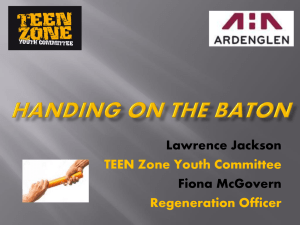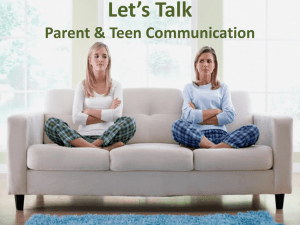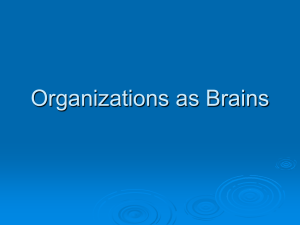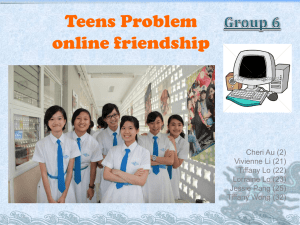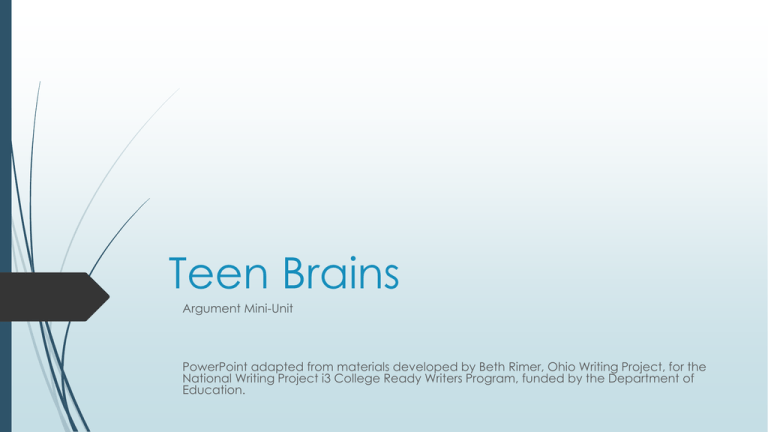
Teen Brains
Argument Mini-Unit
PowerPoint adapted from materials developed by Beth Rimer, Ohio Writing Project, for the
National Writing Project i3 College Ready Writers Program, funded by the Department of
Education.
Journal 1
What is the claim this image is making about teen brains?
What is your response to this image?
What do you think about this image as a representation of teenage
brains or how teens live their lives?
Teen
Brain
Journal continued:
Add “For example, . . .” and refer to either the image or
personal examples.
Teen
Brain
Sample Student Response, Grade 9
The picture is claiming that teen brains are very
impulsive and that most of the decisions and
thoughts teens make are under these main
categories. I believe a lot of that is true and that
they eventually grow out of it. For example,
when a teen gets money the first thing they do is
go out and spend it. It's an impulsive decision.
Journal 2: Create a 2-column chart in your notebook.
Watch the video. Jot down facts you hear in Column 1.
Afterward, add your reactions in Column 2.
Teenage Brain Video (We will watch/write 2 times.)
It Says
I Say
Sample Student Response
It says:
I say:
During childhood, the brain makes billions more
connections than we can use.
When does a person switch
from using the amygdala to
the frontal cortex? This
definitely explains the
process of maturity, in a
more scientific way. Which
connections are the ones
that most commonly die
off? Which ones live on?
Well used connections are strengthen, and seldom used
ones die off.
Teen brains work differently than adult brains.
Teen brains use the amygdala. Adult brains use the frontal
cortex instead.
Frontal cortex is where planning, reason, and moral
decisions reside.
Journal 3: Add to your journal writing . . .use your
“They Say / I Say Chart to add a paragraph or
more to your writing about the Teen Brain. Use
sentence starters like these:
“As _____ says, “
“The video text explains …”
“ According to …”
“Supporting my example, …”
“Just as the video …”
“Although the video says …”
“While the video text explains …”
Sample Student Response
According to the diagram of the teen brain, most of the
decisions teens make are impulsive ones. I agree with
this, but I don't necessarily think that's because of their
age. Although the video says most teens use their
amygdala to make decisions while adults use the frontal
cortex, I don't agree with this. What about the adults
that still haven't matured and act like they are
teenagers?
Journal 4:
Read what you have written so far. Then
write what you are now thinking/wondering
about teen brains . . .
Journal 5
Marking the Text with Sticky Notes
Quote the
text!
(paper ones or HD app)
READ “The Teenage Brain” by Amanda Leigh Mascarelli /
October 17, 2012. On sticky notes, capture information (blue)
and your reactions (green).
NEW Information: Yellow Notes
words, lines, phrases, sentences or sections that provide more information
for understanding how a teen brain works
REACTIONS: Green Notes
words, lines, phrases, sentences or sections that strike you in some way
because you have something to say – it extends, challenges, supports or
questions what you already think about teen brains.
Sample Student Responses:
Annotations of the article
NEW INFORMATION (yellow notes)
One region deep inside the brain shows more
activity in adolescents then is does in children or
Adults.
The prefrontal cortex is important because it
teaches the rest of the brain the rules about
how the world works.
In axons, the insulating tissue allows information
to zip back and forth between brain cells much
more quickly. ☺
REACTIONS (Green notes)
They actually use mice for
experimenting this. ☹
Ms Mascarelli supports what
I’ve noticed about my little
cousin. She says that in their first
three years of their lives,
children develop seemingly
endless connections in their
brain circuitry. My cousin seems
to learn everything so quickly.
Now I wish I had learned more
math as a little kid, so maybe it
wouldn’t be so hard now.
Add your sticky notes to the journal
writing you have completed so far
Try to find places that this information “fits” and
stick your notes there.
OR
Add it to the end of your journal writing if your
sticky note is something you haven’t talked
about yet.
Journal 6: What’s your claim?
Make a claim about teenage brains and the connection between
the brain and behavior or choices.
Good claims
Show the writer’s position on the issue
We should or we should not …
It would be better/worse to ….
Narrow the topic (for example, applying the research to one area
of teen life or one recommendation)
Try a claim starter:
Because the research says _____, we should or should not _____.
Although the research says _____, we should or should not _____.
Sample Student Response #1
According to scientists, the teen brain is slower than an adult brain. That's why they
say that all teens make bad decisions. In my opinion I think that what the scientists
say does not apply to every teen. There are teens that know how to speak for
themselves and make good decisions and stay out of trouble. There are other
teens whose attitudes and decisions do apply to what scientists say.
Celebration: The writer has formed an opinion after reading the 3 texts.
Area for growth: Remove “In my opinion” and “I think.” Just state your claim. Try to
use the claim starter:
Although the research says teen brains are slower than adult brains,
we should not assume that this applies to every teen.
Sample Student Response #2
Teenage years are a time for experimenting and testing the limits. It’s the time
in our lives where we can make mistakes and learn from them. Even though
brain studies now show that teen brains tend to be impulsive and emotional,
we should not change the rules and laws relating to teens just to protect us
from negative consequences. To do that would eliminate important
opportunities for us to try our wings.
Celebration: The writer has formed an opinion after reading the 3 texts.
Next Steps: Make a more specific reference to the research behind this (such
as a quote, a scientist’s name, etc.)
Share claims with a partner and
provide feedback.
Has the writer taken a position or stance on the issue of
teen brains?
Has the writer NARROWED the topic to one idea about
teen brains?
Would the claim starter help this writer be more concise?
Journal 7:
Read what you have written so far.
What Key Words or Phrases might you want
to provide definitions of for your reader?
Sample Student Response
(Circled words
that need to
be defined.)
The teenage brain seems to be a more complex system than adult brain. Their hormones
and chemical balances go off the walls during that period of time. I mean even the
tiniest thing can cause us to lose our flipping minds and freak out. For an example the
chemical dopamine is released when something good happens to a teenager like
finding money or getting a compliment these chemicals can make us feel amazing but
other ones that are released can make us dreadful and down right disgusted with our
self. Our bodies are affected by emotions but are controlled by chemicals that's why
some things affect some people differently than others. You can't be a very emotional
person if you're gonna join the military which also means your brain can't release too
much of a chemical that releases sadness or irrational thoughts. And I agree with the
article but our brains aren't affected by emotions they are affected situations. The
situations cause the emotions or the spikes in certain chemicals such as dopamine. But
people often forget that our emotions are real but they are purely chemical and they
tend to misunderstand how the brain and body usually works. So maybe if people were
to understand their brains and body more maybe they can control themselves more.
Granted you can't change the chemicals balances by turning a faucet hose but you
can THINK about a situation.
Then add to your writing . . . (use your lists of
key words and phrases)
“As Ms Mascarelli says, “
“The article “Teen Brains” in Science News explains …”
“ According to the scientist [name] ”
“Supporting my example, …”
“Although the article about teen brains in Science News
says …”
“While the scientist [name] explains …”
“In addition …”
“Corroborating …”
Key Words (student sample)
-adolescence is a transitional stage of physical and
psychology development that begins at the onset of
puberty, usually between ages 11 and 13, and ends with
adulthood
-prefrontal cortex: the front portion of the brain, just behind
the forehead, which controls executive functions in the
brain.
Journal 8: Practice with the
Harris Moves
Forwarding and Countering
Using Evidence to SUPPORT our Claim
FORWARDING: (Yes, and …)
Illustrating
Authorizing
Extending
We’ll look at an example, then try to find a quote in the article that
we can use to support our own claims about teen brains.
Illustrating—Use as support or find examples in
other texts
Original: “You must be the change you wish to see in the
world.” – Mahatma Gandhi
Illustrating: “Gandhi’s words are true even in every day
life. My mom wanted a neighborhood bike parade, and
rather than waiting, she just did it. She became the change
she wanted.”
Try it! Skim “The Teenage Brain” by Amanda Leigh Mascarelli
to find a quote that helps ILLUSTRATE your claim. In other
words, it provides an example.
Authorizing—Use the expertise or status of
another writer
Original: “You must be the change you wish to see in the
world.” – Mahatma Gandhi
Authorizing: As Gandhi, a key leader of nonviolent civil
disobedience in India, explains, “You must be the change you
wish to see in the world.”
Try it! Skim “The Teenage Brain” by Amanda Leigh Mascarelli
to find an expert (such as a scientist or researcher) that you
can describe like this, to show “it’s not just me saying this,
here’s a famous researcher who says this.” Then copy or
paraphrase what this expert says. Be sure to tell his or her
credentials (university or organization, for example).
Extending—Put your own “spin” on others’
ideas or examples
Original: “You must be the change you wish to see in the world.” –
Mahatma Gandhi
Extending: The idea of change is often thought to be about something
big like world peace or social action, but what if it also means just
changing our everyday lives: stop complaining, clean up the kitchen,
drive the speed limit in school zones. If we changed little things in our lives
would the big things also change?
Try it! Skim “The Teenage Brain” by Amanda Leigh Mascarelli to find a
quote that you have something more to say about, a quote that you can
make a connection to. Explain how the quote applies to the claim you
have made.
Using Evidence
COUNTERING: (Yes, but …) (On the other hand …)
Arguing the other side
We’ll look at an example, then try to find a quote in
the “Teen Brains” article that we can acknowledge
and then refute.
Arguing other side—Shows the usefulness of the
original argument before countering
Original: Mahatma Gandhi said, “You must be the change you wish to
see in the world.”
Countering: Although Gandhi’s words seem like a good idea, in reality,
changing one person cannot really change that much. I might
change my behavior but that has no effect on the choices that
someone makes in a far away part of the world.
Try it! Skim “The Teenage Brain” by Amanda Leigh Mascarelli to find a
quote that you disagree with. Then explain why that quote is not
applicable to the situation you are writing about or to your claim. Be
sure to use a word like “Although.”
Key Phrases to use as EVIDENCE
(student sample #2)
Pushing limits help teenagers to confront the world on their own
Mice brains work the similar to how teenager brains do
Experts believe that taking chances is a necessary phase growing up
Teen experiences can lead to powerful advantages later on in life
Teens often find themselves trapped between their impulsive tendencies
and their newfound ability to make well informed and logical choices.
Teenagers are sensitive and responsive to influence by friends, desires,
and emotions.
Journal 9: Completing a Draft: Option 1
Go back through your writing to see how it flows. Have you started a new
paragraph every time you have a new speaker? A new topic?
Move pieces around if needed so that you are leading your reader from
your claim to your evidence and finally to your conclusion.
Type or retype your draft to save in your writing folder.
Completing a Draft: Option 2
Drafting Organizer
Review your notebook entries and notes. Select the most
compelling and relevant pieces of evidence and try to apply
them to your claim.
Evidence
Connection
Possible
Outcome or
Result
The text
says…
I say…
If we do this…
Then turn each row into a paragraph for your essay. Add your claim
paragraph from Day 6 and draft a closing paragraph in which you
make clear what readers should now know, do, or think.
Completing a Draft: Option 4
Using one of the Kernel Essay organizational structures,
draft a mini-essay in which you develop a claim with
source material.
Moves Writers Make—Adapted from Gretchen Bernabei’s Kernel Essays—Fun-Size Academic
Writing for Serious Learning
B.
Overview
of the
problem...
Overview
of the
problem...
Some
people
think...
My view
on the
problem...
Here's
what I'm
thinking...
One
response
to the
problem...
C.
Something
Happened
Here's
what I am
thinking...
A question
other
people
have ...
In the
end, I
say...
A
question
that
arises...
In the
end, I
say...
My answer
to that
question
In the end,
I say...
D.
Something
Happened
Here's
what I'm
thinking...
Someone
thinks...
Someone
else
thinks...
In the end,
I say...
Choose one
and write a
flashdraft. Be
sure to use
your journal
entries and
notes in
developing
each section
of the essay.
Use your
sources! And
be sure to
identify
where your
information
comes from.
Completing a Draft: Option 5
Stopwatch Essay
1 minute: Write about something that strikes you as
important about teens or teen brains
Develop Your Writing
Stopwatch Essay
3 minutes: Write about what you know about the way
teen brains work (use the source material you already
have)
Develop Your Writing
Stopwatch Essay
3 minutes: State and then write about your claim (use
both the source material you have gathered and a
personal example)
Develop Your Writing
Stopwatch Essay
3 minutes: Write about implications, extensions or
connections your claim could have for you or your reader:
“Because…” “So, perhaps …” “Now I am wondering, …”
“So, next time, …”
Start a new paragraph for each implication, extension, or
connection.
Revise
Go back and add quotes from the article to your writing.
Develop a concluding paragraph that leaves your reader
thinking or that makes clear what you want readers to do,
think, or believe.

